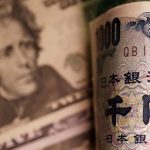
LONDON (Reuters) – The euro fell to a more than two-month low against the dollar and a 12-month low against the pound on Wednesday after survey data showed German and euro area business activity slumped by more than expected in August.
HCOB’s flash Composite Purchasing Managers’ Index (PMI) for the euro area, compiled by S&P Global (NYSE:SPGI) and seen as a good barometer of overall economic health, dropped to 47.0 in August from July’s 48.6, its lowest since November 2020.
The services PMI sank to 48.3 from 50.9, its first time below the 50 mark that separates growth from contraction this year.
The German composite figure fell to its lowest since May 2020 as a deepening downturn in manufacturing output was accompanied by a renewed contraction in services activity.
The single currency weakened after the German data, hitting its lowest level against the dollar since June 15 at $1.0812 and a 12-month low against sterling at 84.93 pence.
“The decline in services activity was a sharp move and we’ve seen a soft euro environment,” said Niels Christensen, chief analyst at Nordea.
“If inflation data continues to slow then the European Central Bank might pause their tightening cycle in September.”
The dollar rose to a two-month peak after the data, with investors also looking to Federal Reserve chair Jerome Powell’s speech this week at the Jackson Hole Symposium for cues on the monetary policy path.
The dollar index, which measures the U.S. currency against six rivals and is most heavily weighted to the euro, rose as high as 103.80, its highest level since June 8. The index is up 1.8% in August, on course to snap a two-month losing streak.
A recent run of strong U.S. economic data has helped allay worries of an impending recession but with inflation still above the Fed’s target of 2%, investors are wary that the central bank may keep rates in a higher range for longer.
“There’s no reason for Powell to close the door for more rate hikes or make a firm promise to hike more,” Nordea’s Christensen said.
“The U.S. economy is slowing a bit but is holding up much better than Europe and that could give the dollar the upper hand.”
Markets are pricing in around an 85% chance of the Fed standing pat at its policy meeting next month, but the odds of the U.S. central bank hiking interest rates one more time this year toward the end of the year have been rising slightly.
The yen strengthened 0.3% to 145.445 per dollar but was not far off the nine-month milestone of 146.565 touched last week, leaving traders on tenterhooks as they warily watch for any signs of intervention.
When the dollar broke above 145 yen last year that triggered intervention, and speculation has begun mounting that Tokyo could soon step into the market to support its currency again if the yen weakens further.
“Despite the proximity to last autumn’s FX intervention level, we see the prospect of intervention below USD/JPY 150 as unlikely and believe that the pair needs to go closer to 155 before MoF (Japan’s Ministry of Finance) considers pulling the trigger,” said Colin Asher, senior economist at Mizuho.
Both this time and in 2022, currency intervention itself would not be a fundamental solution to the yen weakness but could only buy time, strategists at BofA Global Research said.
“The key difference is that while Japan did not have any control over the fundamental cause of the dollar-yen rally in 2022, it can to some extent decide until when to buy time in cooperation with the Bank of Japan because the BOJ controls the short-end of the yen yield curve.”
Another Asian currency that has worried investors is China’s yuan, which is down over 5% this year against the dollar largely due to concerns over the country’s deepening property crisis, which is putting further downward pressure on China’s sputtering post-pandemic economic recovery.
The spot yuan opened at 7.2870 per dollar on Wednesday and was last changing hands at 7.2920.
To read the full article, Click Here

